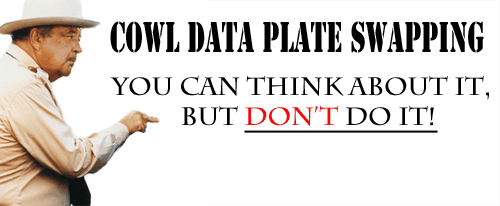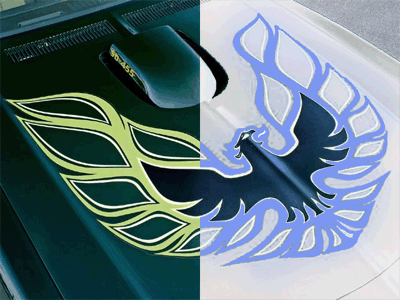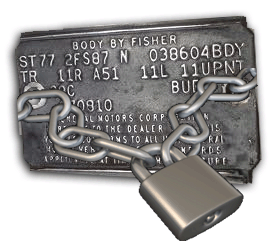
You know the drill. Visit a forum, ask a simple question and get a simple answer. At least we all hope it gets a simple answer….not always. In this online article of forum to frontpage we cover a recent post that started out with a harmless request and covered an age old topic from a different angle. We all know that VIN swapping is illegal, but is that the only thing that can’t be swapped?
 
The cowl data plate holds vital information for your car should you want to know the correct paint color code, interior color and some trim items. Information, such as the creation date and model type can be found there too, but is it really a big deal to have the correct one? I personally thought it wasn’t against the law but it is wrong on a moral level. My logic was simple. If it shouldn’t be swapped why doesn’t the DMV require them to be pop riveted on the body like the VIN tag? The forum community went back and forth with great input and opinions on the matter. At one point a member that was a former member of law enforcement sited a state law and that made me wonder. What about my state? Sure enough a quick call to the North Carolina DMV and I had my answer. There are laws put in place that prohibit the swapping or tampering of a cowl data plate due to the fact that it will portray a car on false pretenses. The laws may vary from state to state, but it is against the law.
You may ask why someone would want to switch the cowl data plate. There are many reasons I can think of but the big two are from opposite ends of the hobby. From the owners point of view lets imagine that you have always wanted a 1973 Brewster Green Trans Am, but the only bird you could find in your area was a cameo white. What do you do? That’s right you paint it GM code 48 and you are set. A person can stop there and be happy, but what if you come across a wrecked Brewster Green TA parts car on craigslist. You take a look in person and it’s still wearing its cowl tag. You stop and think…two screws and I can have a correct paint code plate for my dream car. You think more…I’ll never sell it, so what harm would it cause? You talk to the seller and purchase a few items including the data plate. At that moment no harm has been done. When you get home, clean your new correctly coded data plate up and install it on your bird we cannot say the same thing. At that point you have modified the most basic information that GM has provided for the conservation or restoration of that vehicle. You may be thinking nothing bad has come from it, so what is the big deal? Let’s just say that a couple of years down the road you fall on hard times and make the decision to let go of your dream car to keep a roof over your head. Let us also assume you do the right thing and inform the new owner of your paint conversion, but you forget to mention the cowl data plate swap. It still doesn’t seem that the act of swapping the cowl data plate has caused any harm when in fact the harm will come at the next sell. Most if not all firebird enthusiast know that code 48 Brewster Green was a one year color and brings a higher price than a comparable code 11 cameo white. If the second seller asks a premium price because of the perceived color heritage the bird is being sold on false pretenses. The second seller or even third seller did nothing wrong, but the car is doomed to repeat this scenario until its last day.

On the other end of the spectrum you have the seller. Most people don’t practice the art of flipping cars, so we’ll concentrate on those that do in this example. These are individuals that scour the planet for nice drivers at bargain prices. With a cheap shiny paint job and a little item replaced here and there just about any car can be made to look fantastic on the surface. We’ll go a little further and speculate that the flipper in this example locates a nice Trans Am in the middle of a restoration. The bird is currently wearing primer, but once wore code 69 Chesterfield brown. Flippers try to maximize their profit and with nice SE’s commanding good prices he chooses to clone a Bandit that could net him several thousand more over any other color used in 78’. The SE option was just an appearance package, so replacing an item here and there and a nice decal kit from Phoenix Graphix would require a call to Pontiac Historical Services to prove it wasn’t the real thing. Wait a minute…there is one thing. A true SE would have to have started life as code 19 Starlite Black and that would be right there on the cowl data plate. Oops, sorry this flipper happened to have a couple 78 Trans Am parts cars out behind the shop and one of them happened to be black. You guessed it, he did the easy swap and now a call to PHS is paramount. Not everyone is going to know about PHS, so someone may pay a premium price for a base model bird.

So you see whether you are the owner with good intentions towards your dream car or the seller with bad intentions towards any buyer; the act of swapping will lead someone to believe a car is something it really isn’t. As said previously this is illegal in most if not all states.
So when you are looking for your next bird here are some basic things to look for when looking at a restored or proclaimed original when it comes to the cowl data plate.
1-The cowl data plate should be located on the…cowl of course. It is usually on the driver side just in front of the VIN location.
2-The Body color on the car should match the code. Unless you have a photo graphic memory print off a sheet of the common GM paint codes used for the model you are interested in. GM would often reuse the same color, but would give it another name. Here are the most common colors and codes for the 2nd generation firebird models.
Code-Color
11-Polar White
13-Sterling Silver
15-Platinum
16-Silver (Metallic)
19-Starlite Black
20-Bright Blue (Metallic)
21-Light Blue (Metallic)
24-Martinique Blue, Tahoe Blue, Atlantis Blue
26-Lucerne Blue
29-Admiralty Blue, Nocturne Blue, Stellar Blue, Dark Blue (Metallic)
35-Firethorn Red
48-Brewster Green
50-Solar Gold
51-Goldenrod Yellow, Sundance Yellow, Tahitian Yellow
69-Brentwood Brown, Chesterfield Brown
72-Francisco Red
75-Buccaneer Red, Mayan Red
76-Montruex Maroon
77-Dark Maroon (Metallic)
78-Carousel Red
80-Fiero Bronze
84-Ontario Gray, Dark Charcoal (Metallic)
3-The RPO code for the model is present on all but the base model firebird. Here is a quick list of what you should find based on what firebird you are looking at. *It’s also worth noting that the Van Nuys plant is notorious for not stamping the W or Y RPO codes.
Code-Model
WS4-Trans Am
W60-Skybird
W66-Formula
W67-Esprit
W68-RedBird
W73-YellowBird
4-There are two items on the data plate that can be checked with the VIN and they should match. They are the model year and the production plant. Here are examples showing where to find this information on the cowl data plate and the VIN.
The VIN is usually a 13 character string, but in 81 it was increased to 17. What is important is that the year model will be a single digit in the 6th position. For example a firebird built in 1974 you should find a 4 in the 6th position. The assembly plant will also be a single digit and it will be in the 7th position. There were only two plants that produced the firebird models for the second generation and they were the Norwood Ohio plant represented by the letter N and the Van Nuys California represented by the letter L. The 1974 firebird used in the previous example was produced in Van Nuys, so you should find an L in the 7th position.
The cowl data plate can contain 3-6 lines of information, but the model year and production plant will be listed on the first line. The year model will be two digits preceded by ST on that line. Our 1974 firebird should have a ST74 in the first group on the first line. The production plant will be the third item on the first line and should have a L.
If you are looking at a firebird and those items don’t match that should be a red flag regardless of anything else.
5-The final thing I feel worth mentioning is an optional code stamp used for some SE models. Starting in 1978 many SEs, but not all were stamped with the RPO code Y88 and Y84 code. This seemed to be a common practice at the Norwood plant, but not the Van Nuys plant. I’ve personally never seen or heard of an Y84 in 1979 and later not having the code stamped on the cowl data plate from that year forward, but I’m sure there were some.
So next time you are looking at a firebird, whether it is a potential buy or at a car show peek at the cowl data plate and see if the basics line up. Regardless of the car, knowing what to look for can save you a lot of headache and cash.